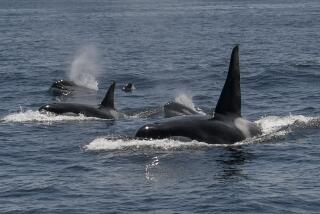Ulysses, Barcelona Zoo’s Disturbed Killer Whale, Stirs Passions of Well-Wishers
- Share via
BARCELONA, Spain — Ulysses the killer whale is psychologically disturbed.
Twelve years since he was captured off the east coast of Iceland, he is starting to behave abnormally and aggressively. Not only that, but he has grown too big for his seafront pool at Barcelona Zoo.
The zoo wants to send him to a marine park in the United States, but animal welfare groups in Spain and abroad are preparing a campaign to have Ulysses returned to the sea instead.
Biologists say killer whales--they call them orcas--are normally gentle creatures. But Ulysses has begun to bite his cleaners and chew his tongue. He also “looks bored,” keepers say, and chases the female dolphin who shares his pool.
Males have a life span in the wild of around 30 years, females 50 years. Ulysses is 14, just approaching maturity.
The zoo fears that the 20-foot-long mammal is suffering from the confines of his pool, which measures 72 feet from corner to corner and is 16 feet deep.
Ulysses’ dorsal fin is atrophying from lack of use.
Eric Hoyt, adviser to the British-based Whale and Dolphin Conservation Society (WDCS), said that in the wild an orca would swim 6,000 to 9,000 times as far as the size of the pool in an average day.
There is a real danger that the whale will become more and more aggressive, Hoyt said.
The zoo decided in November to transfer Ulysses to one of the Sea World parks in the United States, probably in San Diego, until a new and bigger facility is built here in three years.
The zoo has also taken note of a proposal by the WDCS and the Barcelona-based Assn. for the Defense of Animal Rights (ADDA) to return the whale to the Atlantic off Iceland.
They say the plan to fly Ulysses to Sea World in a jumbo jet will go ahead but they will also consult international experts to see if he should be returned to the wild later.
Animal welfare groups are furious at the decision to go ahead with the move to Sea World, even using well-tried technology, before consulting experts.
Sean Whyte, founder and executive director of WDCS, in a letter to zoo director Enric Mas, called the decision “a very sad day for Barcelona.”
The letter, a copy of which went to Barcelona Mayor Pasqual Maragall, went on: “I do so hope it will be possible to tell my colleagues that it will not be necessary to mount a worldwide campaign against you and the zoo. Such a matter would reflect very poorly on Barcelona.”
If Ulysses were to be sent back to the open sea, it would be the first time for an orca, although similar attempts have been made with other species.
French marine biologist Jacques Cousteau told the Barcelona newspaper La Vanguardia he favors the idea of a return to the wild, despite all the risks and with no guarantee of success.
“If there is an exhaustive study beforehand by proper experts, the successful outcome of an initiative such as this would be an important advance,” Cousteau said.
Hoyt of the WDCS also believes a successful return to nature is possible.
“The main problem would be retraining the orca to catch live fish,” he said.
The WDCS believes it is possible to identify the pod or family group of up 50 killer whales that Ulysses came from, as each group has distinctive dialects or voice patterns.
A transition period of between two and six months, aided by a trainer and monitored by veterinary experts, in a closed area such as a fiord, would give the whale a better chance of survival, Hoyt said.
The WDCS is critical of the operation of marine parks, and their record with orcas.
“If he is sold or given to the Americans, he is gone forever,” said Whyte. “He is basically going to a circus and there is no future for him.”
More to Read
Sign up for Essential California
The most important California stories and recommendations in your inbox every morning.
You may occasionally receive promotional content from the Los Angeles Times.










